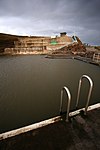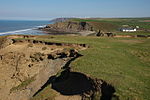Bude Canal
BudeCanals in CornwallCanals opened in 1823Geographic coordinate listsIndustrial archaeological sites in Cornwall ... and 4 more
Industrial archaeological sites in DevonLists of coordinatesUse British English from January 2017Works of James Green

The Bude Canal was a canal built to serve the hilly hinterland in the Devon and Cornwall border territory in the United Kingdom, chiefly to bring lime-bearing sand for agricultural fertiliser. The Bude Canal system was one of the most unusual in Britain.It was remarkable in using inclined planes to haul tub boats on wheels to the upper levels. There were only two conventional locks, in the short broad canal section near the sea at Bude itself. It had a total extent of 35 miles (56 km), and it rose from sea level to an altitude of 433 feet (132 m). The design of the canal influenced the design of the Rolle Canal.
Excerpt from the Wikipedia article Bude Canal (License: CC BY-SA 3.0, Authors, Images).Bude Canal
Lower Wharf,
Geographical coordinates (GPS) Address Phone number Website Nearby Places Show on map
Geographical coordinates (GPS)
| Latitude | Longitude |
|---|---|
| N 50.8275 ° | E -4.5479 ° |
Address
Olive Tree
Lower Wharf
EX23 8LG , Bude–Stratton
England, United Kingdom
Open on Google Maps









